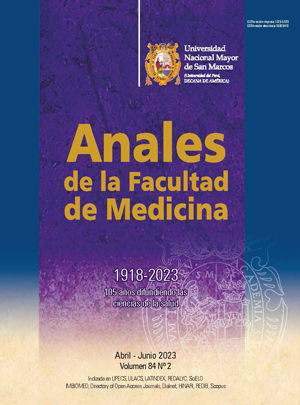Prevalence of Giardia lamblia by ecoregions in Peruvian preschoolers and school-aged children: Risk stratification proposal
DOI:
https://doi.org/10.15381/anales.v84i2.25351Keywords:
Giardia lamblia, Prevalence, Students, Meta-Analysis, Health PrioritiesAbstract
Introduction. Giardiasis is caused by an intestinal protozoan, Giardia lamblia. Despite its high prevalence and geographical transmission variability, there is no risk stratification tool available to prioritize interventions. Objective. To estimate the prevalence of G. lamblia in Peruvian preschoolers and schoolchildren by ecoregion from 1990 to 2018. Methods. Based on a previous meta-analysis, we conducted a G. lamblia prevalence sub-analysis by ecoregions from data of 26 studies in Peruvian preschoolers and school-aged children between 1990 and 2018. The data was extracted by district, a classification by ecoregions was made through Google Earth. Heterogeneity was analyzed using Cochrane Q test and publication bias applying the Egger method with StatsDirect version 3.2.7. The absolute risk method was performed to stratify the prevalence at district level, and 4 strata were defined based on percentiles or arbitrarily. Results. Forty-three district-level prevalence data was estimated, including 7,606 participants. The highest pooled prevalences by the randomeffects method of G. lamblia were 47.0% (95% CI: 40.0-54.0) in the Pacific desert, 27.9% (95% CI: 22.8-33.2) in the lowland forest and 26.9% (95% CI 22.5-31.5) in the Puna. Conclusions. Of every 100 preschoolers and school-aged children living in the Pacific desert, lowland forest, and in the Puna ecoregions, 47, 28, and 27 minors are infected with G. lamblia, respectively. Likewise, 4 risk strata are proposed based on prevalence: sporadic (0 to <1%), hypoendemic (1 to <25%), mesoendemic (≥25 to <50%) and hyperendemic (≥50%).
Published
Issue
Section
License
Copyright (c) 2023 Anales de la Facultad de Medicina

This work is licensed under a Creative Commons Attribution-NonCommercial-ShareAlike 4.0 International License.
Those authors who have publications with this magazine accept the following terms:
- Authors will retain their copyrights and guarantee the journal the right of first publication of their work, which will be simultaneously subject to Creative Commons Attribution License that allows third parties to share the work as long as its author and its first publication this magazine are indicated.
- Authors may adopt other non-exclusive licensing agreements for the distribution of the version of the published work (eg, deposit it in an institutional electronic file or publish it in a monographic volume) provided that the initial publication in this magazine is indicated.
- Authors are allowed and recommended to disseminate their work over the Internet (eg: in institutional telematic archives or on their website) before and during the submission process, which It can produce interesting exchanges and increase quotes from the published work. (See El efecto del acceso abierto ).















